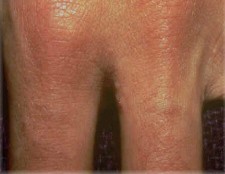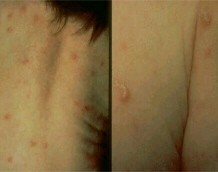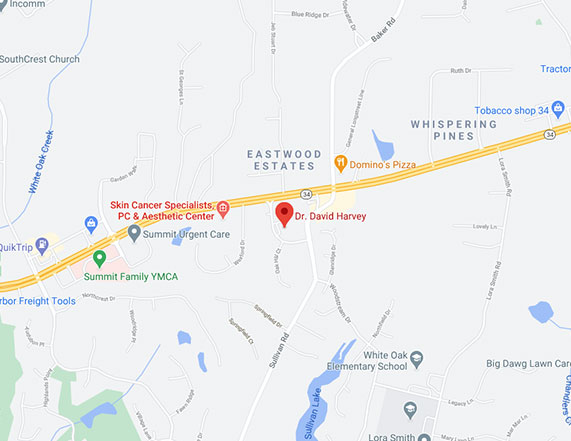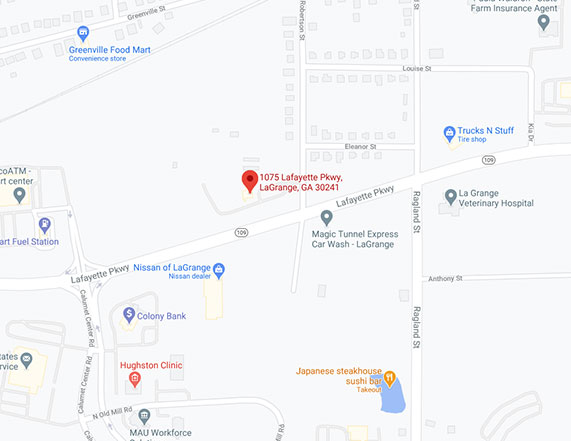Conveniently located to serve Newnan, Peachtree City and LaGrange
Click here to jump to:
Newnan Scabies
WHAT IS SCABIES?
Scabies is a highly contagious disease of the skin which can cause intense itching and discomfort. Most cases of scabies occur because of incidental contact. Scabies is attributed to a female mite, which is too small to see with the naked eye. This mite can burrow into the superficial layers of the skin where it thrives. Itching results when our body attempts to eliminate the mite from the skin.

Scabies Burrows – seen a linear eruption between fingers and toes.
WHAT ARE SOME COMMON SYMPTOMS OF SCABIES?
The most common symptom of scabies is intense nightly itching. The rash can affect the neck line, fingers, waist line and belly button area. Genitals, breasts, and underarm regions can also be affected. Initially, the rash may present with burning or tingling. Lesions manifest as a small linear burrow. This burrow can be examined under the microscope in order to detect the mite or one of its byproducts. Once diagnosed with scabies, it is important that all family members and close contacts be treated.
WHO IS AT RISK FOR DEVELOPING SCABIES?
The disease is far more common among groups living in crowded conditions. Scabies is prevalent in nursing homes, daycare centers and those who have close physical contact with others.
IF I CONTRACT SCABIES, AM I AT RISK FOR DEVELOPING OTHER DISEASES?
Outside of an occasional bacterial infection, this rash does not place one at risk for other systemic diseases.
Related
Content
Patient
Review
“Nothing I would change. It was a great experience. Everyone is wonderful.”
by Anonymous
IS SCABIES EASY TO TREAT?

More burrows – seen on gluteal and posterior neck creases. Rash usually spares the head and face regions.
Yes. Thankfully, treatment today is very safe and effective. The therapy most often employed utilizes a special cream called permethrin. The cream is applied from the neck down and thoroughly massaged into the skin. It is left on overnight and removed the next morning by bathing or shampooing. Repeats treatments can be carried out in 2 to 3 weeks. Resistent cases can be treated with an oral medication called ivermectin.
HERE ARE A FEW OTHER THINGS TO KNOW ABOUT SCABIES TREATMENT:
1. Itching and mild burning may occur after one treatment with your prescribed cream. Typically, itching improves within the first 24 hours after medication application.
2. Remember to treat all close contacts at the same time.
3. It is important to change all clothes and bed linens and to have affected clothing articles washed at the same time using hot water. Often it is useful to place clothing through an extra rinse cycle to ensure appropriate cleaning. It is usually not necessary to treat sweaters, jackets, furniture, drapes or rugs as the mite cannot survive on these areas for a prolonged period of time.
HOW LONG AM I CONTAGIOUS AFTER TREATMENT? CAN I RETURN TO WORK?

Scabies Mite – Female tunneling a “burrow” and causing raised rash.
The scabies mite does not usually survive the first treatment however, your rash and itching may persist up to 4 weeks after treatment because of your bodies reaction to mite by-products. Sometimes, Dr. Harvey will have patients reapply their prescribed cream a week or two after the first application to ensure that all mites are eliminated. He may also employee a topical anti-itch compound which contains a mild corticosteroid combined with Sarna lotion. This is kept refrigerated to provide a more soothing treatment. Finally, nightly oral antihistamines may be prescribed to help with itching and insomnia. You may return to work after one application of your prescription cream. It is important to let your employer know if you have been treated for scabies so that contacts with other employees can be evaluated. All contacts should be forewarned and, if they have symptoms, they should be examined and treated by a qualified physician.
SUMMARY
Scabies is a common skin disorder. More than one treatment may be required to clear the rash. Our providers may recommend:
- Lindane 1 % lotion as directed.
- 6% Sulfur mixed in petrolatum as directed.
- Elimite (Permethrin) 5% Cream as directed.
- Ivermectin orally as directed. One dose is usually curative
- Apply and gently massage the prescription cream into all skin surfaces from your head to your feet. Be sure that infants and elderly patients are treated on the neck, scalp, temple and forehead. The prescription cream should be left on overnight and washed off the next morning by bathing or shampooing.
- It is extremely important to put the prescription cream on every square inch of your body; not just where the rash is. That includes applying it under your fingernails and toenails, around the nail beds, between your fingers and toes, and in the cleft of your buttocks and genital area. If you wash your hands or any other area during the treatment period, new cream must he reapplied immediately.
- If itching. mild burning and/or stinging occur after the first application, let our providers know of this immediately.
- All close contacts should be treated at the same time.
- Be sure to change your clothes anti bed linens, and have all affected clothing articles washed at the same time using a hot water cycle or professional dry cleaning. It is usually not necessary to clean sweaters, jackets, furniture, drapes, or rugs.
- You will not usually be contagious after one treatment if instructions have been followed carefully. The scabies mite will be eliminated in a matter of days: however, your rash and itching may persist up to 4 weeks after treatment. This is rarely a sign of treatment failure and is not necessarily a indication for retreatment. If itching is excessive or persists, please contact our office immediately.
- Avoid contact of the cream with your eyes. If it accidentally gets in your eyes, promptly flush with water immediately.
- Corticosteroid cream with Sarna- Apply 2 to 3 times daily to help with itching after your initial treatment to kill the mite. Keep the compound refrigerated to allow for a more soothing treatment.
- Use nightly antihistamines to help with itching and insomnia.
- Be sure to schedule an appointment for a follow-up examination in 2 weeks.
If you are concerned about a possible scabies rash, it is wise to have us evaluate you. Click here to set up an appointment. We look forward to helping you.











